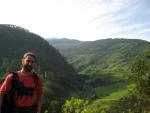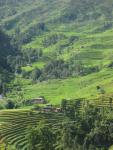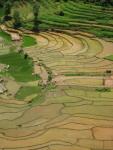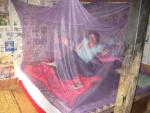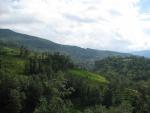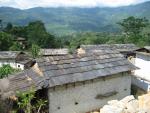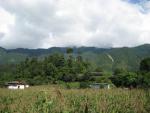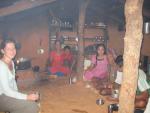Thirsty work
Sat 18th Jul 2009 — drew
After a slight mishap with alarms, we woke at 5.20 when we were meant to be meeting Marianne at the bus stand at half past five. Thankfully we'd done most of our packing the night before so we managed to get out quickly and find a taxi. However, there was nobody on reception so we had to just leave our bag of surplus stuff behind the desk (we had agreed with them that they'd look after it for us)... we hope it's still there when we get back.
Finding Marianne in the chaos of the bus stand fully laden with our bags was no easy task. Shouting our destination at people seemed to have them all pointing in different directions, and us walking around in circles. With only minutes to spare we caught sight of her and managed to get all three of us onto the bus before it pulled away.
The bus from KTM to Charikot follows one of the major 'highways' of Nepal; whilst even the most rural tracks in Britain would put sections of it to shame, it was certainly better than the muddy quagmire we got stuck in the week before. The bus journey took us through the district headquarters of Charikot (having made a stop for dhal bhat and a couple of quick pit stops for people to relieve themselves at the side of the road) which looks like a nice enough town - we expect we'll be paying it a proper visit at some point during our stay in Garimudi.
Not long afterwards the English teacher of the school, Ram, got on the bus and we had a chance for quick introductions before we all piled off at a village called Busti. Having thought this school was in a village that's reachable by road, we were now informed that during the monsoon the last part of the road is closed, and we'd be walking it.
Marianne had brought nearly 100 books for the school in her rucksack, so this was very heavy. Thankfully she'd also arranged for our host, Devendra, to meet us from the bus and he's a trek chef who's used to heavy rucksacks. We had no such luxury this time around, and had to carry big rucksacks on our backs and our smaller bags strung around the front. Ram told us several times how lucky we were that it wasn't raining, but the blazing sunshine which was uninterrupted for the three hour uphill walk made us all pour with sweat. Unfortunately our hurried departure in the morning left us with insufficient drinking water for this sort of endeavour, and we spent the last hour or so feeling a bit like cartoon characters crossing the desert on hands and knees longing for water. We did our best despite this to appreciate the lush hillsides we walked through, beautiful pine forests, and the truly impressive terraced paddy fields which seem to cover every inch of the hills.
We arrived fairly exhausted and very dehydrated and were soon given a very welcome cup of tea made with rich buffalo milk. We wasted no time getting on with pumping water through our filter – sadly we then had to endure a tantalising half hour wait once we'd treated the filtered water with chlorine (we've been warned to be even more careful with 'village water' down here at lower altitude). We took turns pumping litre upon litre of water which we gulped down as soon as it was ready to drink.
Having recovered slightly we got shown to our home and room for the month. Everything is built in a very different style to Melamchi; whilst there most houses were stone and wood with tin roofs and the living quarters mainly on the first floor well above the ground, with an iron stove and chimney, here they are wood and stone but this time with a render made from the red clay soil which forms the floors – even upstairs – and the roofs are generally wood or slate. Whilst we are lucky enough to be staying in a very handsome and well-built house, the village in general seems less affluent, which is what we'd been told to expect. Just to the side of the house is a wood shelter for the buffalo, chicken and goats, and the water hose which is the tap, shower and kitchen sink. On the other side is a very basic squat loo. Surrounding the house is the family's field of corn which is above head height, but not yet ready for harvest. Our room is on the ground floor, with newspaper lining the walls and plastic sheeting coating the ceiling. On the first floor is Devendre's family's accommodation. He has one son Bairagi, a daughter Parbadi, and his wife is called Ratna Maya (they also have an older daughter who is now married and lives in KTM). On the top floor in the attic, with a low pitched ceiling is the kitchen, where there is a small stove with an electric fan (to be more efficient, use less wood, and produce less smoke) but no chimney.
We are very lucky that our host is a trek chef, as the food so far has been excellent, with fresh vegetables (or chicken!) collected from the garden with every meal. The meal routine is slightly different, with dhal bhat for breakfast before school, which sees us through to a dinner of dhal bhat at around 7 or 8. This is apparently much more typically Nepali, and the break during the school day is called 'Tiffin time' where we have been enjoying some piping hot pepper tea from the nearby chiya shop.
Although term has officially started at school, this is one of the busiest times of the year for the village and it seems almost everybody is out in the fields planting rice. This means a lot of the students are helping in the fields – Marianne pointed out that this could be seen as the school condoning child labour but the teachers seem to think that this is perfectly normal and the kids will be back in school soon.
Despite this, there was still a good welcoming committee when we arrived for our first morning at the school and we were presented with lovely (real) flower garlands. We are the first volunteers ever to come to this school and as this area is not on a trekking route they don't see very many foreigners at all and we've certainly had many curious little faces watching our every move.
- ‹ previous
- 14 of 70
- next ›

